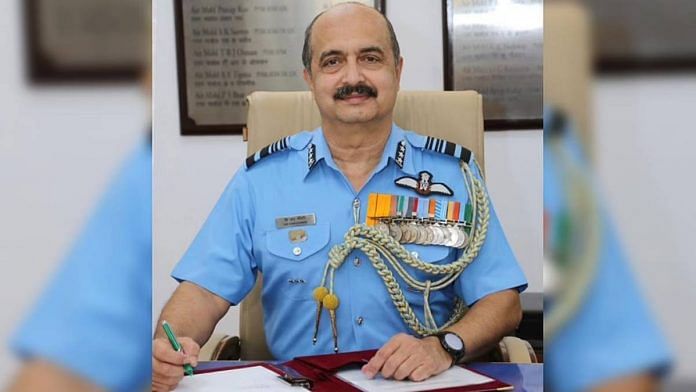New Delhi: Indian Air Force Air Chief Marshal (ACM) V. R. Chaudhari Friday warned against the creation of an Air Defence (AD) Command, planned under the theaterisation process, without it having offensive capabilities. Chaudhuri said that division of offensive capabilities was “ineffective in design or execution of the joint strategy”.
The Air Chief Marshal made it clear that modern 4.5 and 5th generation aircraft have omni-role capability, and to restrict those aircraft to any one role would lead to their underutilisation.
“Flexibility, one of the characteristics of air power, gives a planner the freedom to swing roles depending on the air situation, and this must be capitalised on,” he said, while addressing a seminar organised by the Centre for Joint Warfare Studies (CENJOWS).
His comments came at a time when the theaterisation process envisions an Air Defence Command under the Indian Air Force and aviation assets being split into other theatres.
The IAF, which has been supporting jointness, is of the view that there should only be once Command — India Command — with all the three Services working in synergy.
Talking about the topic of the seminar, Air & Missile Defence, Chaudhari said there was a “dichotomy”.
“Air Defence encompasses countering all hostile projectiles that travel through the medium of air. Hence, to differentiate between Air and Missile Defence as two separate entities would be like creating additional silos within the Air Defence vertical,” he said.
The IAF chief said that while there is a need for close coordination between all elements within the same airspace to ensure aerospace safety, as well as effective air defence, the creation of an AD Command may prove counter-productive.
This was “because, Air Defence operations are inextricably linked to Counter Air Operations and all offensive ops (operations), as the success or failure of one, will dictate the demands on the other. AD and offensive missions are interdependent and if executed in isolation, these would not only be disjointed but also ineffective in design or execution of the joint strategy,” he said.
Also read: What are military theatre commands and why does India want to switch to them
Threats from sub-conventional aerial platforms
ACM Chaudhari noted that in September 2018, two major oil facilities, Abqaiq and Khurais run by Saudi ARAMCO were successfully attacked by a combination of 18 drones and seven cruise missiles.
Between December 2017 and January 2018, Russians were successful in foiling multiple attacks by miniature armed drones on the Khmeimim airbase in Syria.
“Lessons learnt from past events like 9/11 (US twin tower attack), LTTE attack on Katunayake airfield (in 2001) and post Balakot events (of 2019) have changed the concept of sanctity of air space and have further underlined the need for a credible Air Defence. The drone attack on Air Force Station, Jammu in June last year also brings to light the swathe of threats that we are likely to face,” he said.
He added that proliferation and easy availability of aerial platforms and precision weapons has made installations highly vulnerable.
“In view of the prevailing threat scenario in the country, utilisation of sub-conventional aerial platforms by anti-national elements, against our vital strategic and military installations cannot be ruled out. The ongoing conflict in Ukraine has once again brought into focus the effectiveness of MANPADS (Man-portable air-defense system) especially in urban and semi-urban areas,” he said.
ACM Chaudhari added that traditionally, air power is defined as the ability of a nation to exert its will through the medium of air.
As a corollary, air defence can be defined as the ability of a nation to prevent an adversary from exerting its will through the medium of air, he said.
“This would include the entire array from drones to hypersonic glide vehicles and aircraft to ballistic and cruise missiles. To counter this rapidly evolving spectrum of threats, robust integrated defence systems are required to protect critical assets and allow a timely response,” he said.
(Edited by Poulomi Banerjee)
Also read: Joint military command is the future but India can’t rush into it






